 Leading Blog | Posts by Month |
 Leading Blog | Posts by Month |
02.28.19

LeadershipNow 140: February 2019 Compilation
See more on 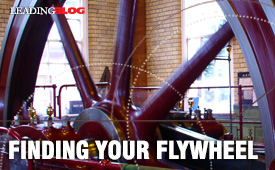 
Posted by Michael McKinney at 07:51 AM
02.27.19

The Leadership Killer
THE LEADERSHIP KILLER is in all of us, all of the time, just waiting to strike. It doesn’t discriminate—neither gender or race. The ironic thing is, we give it permission to kill. It’s our choice. In The Leadership Killer, Bill Treasurer and Captain John Havlik expose the leadership Killer. It’s hubris. Arrogance. It has killed more leaders than any other leadership flaw. The fact that we have seen and experienced leaders seduced by their egos makes this book vital and timely. It is a short book but full of great insights and perspectives on hubris and its antidote, humility. Hubris is the abuse of power that is inherent in leadership. And the more powerful we become—the more successful we become—the more easily we are to be seduced by it. We can believe that we deserve to act any way we want. We are above the rest. Good leadership requires the right use of power. Treasurer and Havlik, ask, “How will I use my leadership power?” When a leader is full of hubris, the most basic aim of leadership—to improve the lives of those being led—gets twisted. Hubris turns a leader’s attention away from enriching the lives of others, to enriching himself. Most leaders don’t start out that way. But in time, hubris creeps in to twist our thinking, kill our purpose, our ethics, and our reputation. Each of us is capable of good and bad behavior. Ego is not inherently bad but it must be mastered. Unless you have mastery over the totality of your own nature, you will be prone to causing a lot of leadership damage. How the Killer Creeps In The demands and pressures of leadership can create a foothold for hubris. Hubris is always looking for an entry point. There are three basic areas where our ego can get the best of us. The first is the pressures associated with being responsible to others. As a result, we often overlook taking care of ourselves—our health and personal relationships. The Killer is on the lookout for the self-neglectful leader who is weighed down with the burden of responsibility. It knows that the more responsibilities the leader is carrying, the more the coiled spring of irresponsibility wants to burst forth with non-leaderlike expression. Such a leader, hubris knows, is vulnerable to making impulsive choices that give him temporary escape or relief from carrying responsibility’s heavy burdens. It knows that the more exhausted a leader is, the more susceptible he’ll be to character erosion, where principles can soften to the point of being compromised. Then there’s the relentless pressure of having to produce results. Leaders are responsible for results, but when that become their primary focus, the ends can become more important than the means. And that almost guarantees that we will mistreat others. The Killer wants the leader to be gluttonous for results, obsessed with getting more out of everyone and everything. If the Killer can get the leader to judge his or her worth only against their contribution to a financial end, it can make them pay less attention to all the important means to that end. Finally, there are the pressures associated with having to perform in the role of a leader. The typical expectation of a leader is invincibility. You know and can-do. At the same time, the needs of others put you in a position of having to be different things to different people. Leadership often requires that you be all things to all people. The danger of over-attending to the role of a leader is that you may start to lose sight of your true self. Some leaders get so wrapped up in the role that they don’t know how to step out of it. Hubris’s work will be much easier if you have no sense of self, no depth and dimension, and no sense of identity beyond your leadership role. Not surprisingly, our success can be the biggest source of our downfall. It’s easy to think that when we are on a role, the rules don’t apply to us and we should—or rather deserve—special treatment. While success is good, success alone is not the point of leadership. As the author's point out, “Success is an outcome.” Our perspective should be bigger than that. Leadership is more about the “positive impact that your leadership can have on the people you’re leading and by extension the organization you’re serving, by embodying a set of values and virtues as you meet challenges that push against them.” What About Confidence? Hubris easily masks itself as confidence and it can be hard to see the distinction. Trying to do it all yourself, refusing to ask for help, playing the victim, can all be manifestations of hubris. True confidence is full of genuine humility. True confidence doesn’t need your affirmation. True confidence isn’t threatened when others experience success or rise in the ranks. It takes joy in contributing to it. True confidence knows its own value and is sober about its weaknesses. True confidence knows it can learn from everyone, and everyone deserves to be listened to and valued. True confidence doesn’t need to pretend it’s something it’s not, or put on airs of superiority or invincibility. True confidence doesn’t brag. True confidence is comfortable in its own skin, and wants to put you at ease so you can be comfortable in yours. How Do We Guard Against the Killer? In the overall scheme of things, we are not as big a deal as we think we or others might think we are. Acknowledging that the Killer is there inside each of us poised to kill our leadership is half the battle. That knowledge gives us a chance to control it. Ego is not something you eliminate; it is something you manage. We guard against our ego primarily by allowing others to call us on it. Who gives you honest feedback? “They are your best hope for keeping grounded and levelheaded when your ego gets overly inflated and aim to float into the stratosphere.” Build those relationships. The stronger they are the better your feedback will be. Leaders thrive when they allow others to call them on their ego. Ask questions. None of us has all of the answers. Get out and talk to people who are closest to the work. They will give you insights and appreciate the access they have to you. Don’t pretend to be perfect. All of us have weaknesses. “People want to be led by leaders who are seasoned and scarred because that’s how wisdom is gained.” Show gratitude. Thank those that are contributing to your success. “Let people know why you’re grateful for them and the impacts they’ve made on you and your life. Gratitude and humility go together. Finally, and not so obvious is to identify the things you find threatening. Name your fears. “Hubris feeds on fear. The more threatened your ego feels, the more it will act preemptively against what it finds threatening. At the core, arrogant leaders are fearful leaders. They externalize their own fear by intimidating you into being afraid of them. The more afraid of them you are, the less threatened they’ll feel.” The final question becomes for each and every leader: Will you lead or rule? 
Posted by Michael McKinney at 12:01 AM
02.25.19

Workplace and Life Advice You Can Use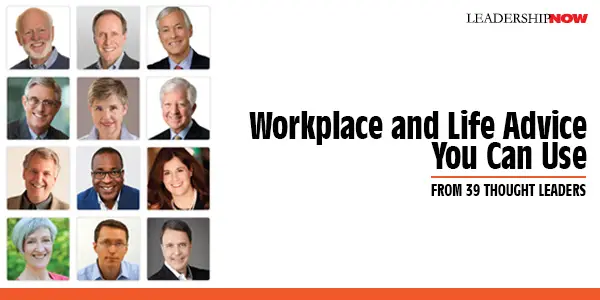
THIRTY-NINE LEADERS were interviewed on subjects related to leadership and were assembled by Roger Dean Duncan into LeaderSHOP Volume 1: Workplace, Career, and Life Advice from Today’s Top Thought Leaders (not to be confused with the LeaderShop). Duncan asks great questions, and the responses are interesting and well worth reading. The book is organized around 10 topics. Here is a sample from each: Meaning and Purpose
Mental Maps
Workplace Practices
Behaviors
Trust and Teamwork
Culture
Feedback and Accountability
Communication
Career Management
Personal Balance
Some of the advice will resonate and some will not. Much of it you will agree with and some will sound more like pandering. But as Jon Acuff points out in his chapter, “If none of this advice applies to you, find some advice that does. Just don’t be like the young college graduate I met. I asked her, ‘Who is doing the kind of dream job you’d like to do someday? Who can you learn from?’ She said, ‘No one is doing what I want to do.’ I immediately thought, ‘Sure, you went 0 for 6 billion. There’s not another human alive you can learn from.’ I don’t think every bit of advice fits every situation, but I promise there’s someone out there who has some you can apply to your career.” You will find some very good advice in LeaderSHOP. 
Posted by Michael McKinney at 01:55 PM
02.20.19

The Critical Few: Working with Your Culture to Change It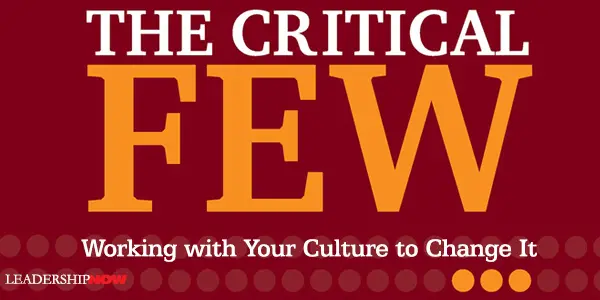
CULTURE is hard to change. And we’re usually fighting against it. But what if we used the culture to change it? What if by focusing on a few critical elements we could work with our culture instead of against it? In the Global Culture Survey 2018 by The Katzenbach Center, a whopping 80% of respondents say their organization’s culture must evolve in the next five years for their company to succeed, grow, and retain the best people. I think we’re all there, so the challenge is how to make that happen. In The Critical Few, the authors—Jon Katzenbach, Gretchen Anderson, and James Thomas—describe organizational culture as “a collection of deeply held attitudes, entrenched habits, repeated behaviors, latent emotions, and collective perceptions of the world. Culture is the shared set of assumptions we all bring when we work together—our unspoken expectations of one another.” It’s easy to underestimate the powerful force exerted by the culture when trying to change it. Instead of issuing top-down, comprehensive, urgent, cultural change directives, you’ll get further faster with real transformation, if you can get the “important emotional forces in your current culture working with you. You identify and make use of what already exists. Chances are, there are some reservoirs of genuine positive emotional energy lurking somewhere within your current cultural situation that can be harnessed if brought to light.” The idea then is to align how people behave and feel—those cultural elements that motivate your workforce—with your goals and what is necessary to make the company successful. But you need to keep it simple. The tendency is to include too much—too comprehensive. Complexity is distracting; comprehensiveness is wasted energy. You need crystal-clear simplicity and a small group of elements that will carry everyone forward together. You need to unify your organization’s people around a common, clear cultural movement, driven by a core of keystone behaviors and positive emotions. It’s easy to create a long list of very important and necessary keystone actions that are vital to building a better culture. But if you can’t narrow it down to three or four, “you’ll be overwhelmed when you start to work with them, and so will everyone else in the organization.” So we need to focus on three specific elements they call the critical few to have the most success: existing cultural traits, keystone behaviors, and authentic or critical informal leaders. Here’s how they describe each: Existing Cultural Traits A set of shared characteristics that represent the “family resemblance” of your entire enterprise—the qualities that transcend subcultures and are at the heart of the shred assumptions people bring to work and their emotional connection to what they do. Traits are not values. They reflect how things are actually done. When we understand what core qualities make up the “family resemblance,” we can than encourage the most the best and useful aspects of those qualities to bring about the change in culture. The traits you choose to focus on should “reflect your company’s essential nature, resonate across the enterprise, trigger a positive emotional response, and support your company’s cause.” Emotional energy is released as traits (and behaviors) are defined because traits, when well-articulated, reinforce and remind people within an organization of their sense of belonging to something larger than themselves. Keystone Behaviors A few carefully identified things that some people do, day after day, that would lead your company to succeed if they were replicated at greater scale. Culture change is slow process, but it begins with specific changes in behavior. As Richard Pascale wrote, “People are much more likely to act their way into a new way of thinking than to think their way into a new way of acting.” You are looking for behaviors that, when encouraged, will move your organization in the direction of your stated aspirations and your strategic intent, all while aligning to those fundamental traits of who you are as a company. Authentic Informal Leaders A few people, or at least a reasonably small percentage of your company’s people, who stand out because they have a high degree of “emotional intuition” or social connectedness. Authentic Informal Leaders (AILs) are people who are already demonstrating the kinds of behavior you want to encourage. And they are not necessarily your high-flyers. These are the people too that can give you a better understanding to how things really work in your organization. Work with them from the beginning. They note thought that AILs may be thought of as skeptics, resistors, and even “mouthy.” Their value is that they “aren’t just there to channel a message—they are there to translate it if they believe in it and also to call foul if they do not and push the leadership to try harder! Their talent for sensing and responding to what others think and feel means that they will choose a way of communicating key ideas that will strike a chord at all levels of the organization.” You can’t point your finger and mandate behavior change. But you can intervene to create the conditions that make the right behaviors emerge. You’re looking to surround your people with a coherent system of “enablers,” some formal and some informal, that all, taken together, suggest a new path. Too often we try to implement changes as an initiative against something when we would be better off working with the prevailing culture to shape something better. These initiatives are usually communication-led transformation rather than a true culture-led, behavior-led, transformation. Communications-led transformations rarely produce a lasting effect on how we feel about what we do and therefore actually change what we do. Lasting cultural changes must have an emotional commitment. You can find more information on this concept on the Strategy& website. 
Posted by Michael McKinney at 08:34 PM
02.18.19

Lessons from Washington & Lincoln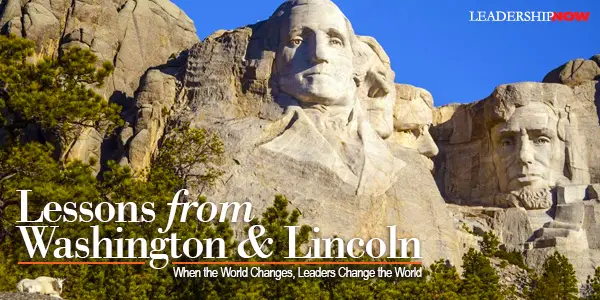
PRESIDENTS DAY was created in 1968 when George Washington’s birthday (February 22) was moved to the third Monday of February as part of the Uniform Holidays Bill. Today it is thought of as a day to remember all U.S. presidents but with a focus on the lives of Washington and Lincoln who was also born in February (12th). Both of these leaders possessed a great deal of self-awareness. Washington’s success, in part, came from knowing his weaknesses and controlling them. Lincoln listened. Lincoln took the time to cultivate personal relationships with his subordinates so he could learn from them. Lincoln accepted criticism, but always, he kept a good sense of humor. He chose not to brood over any criticism. No one is a born leader. Their leadership development began early in life—as it should. Great leaders are revealed in extraordinary circumstances, but they are made long before. By age sixteen, Washington had copied out by hand, 110 Rules of Civility & Decent Behavior in Company and Conversation. These rules proclaim our respect for others and in turn, give us the gift of self-respect and heightened self-esteem. These leaders knew who they were and their times. And they lead. Their lives are an example for each of us, and if we are wise, we can use them to inform our own leadership in any context. When the world changes, leaders change the world. Explore the links below to learn more.
Posted by Michael McKinney at 04:57 PM
02.17.19

Thomas Jefferson's Ten Rules to Live By
THOMAS JEFFERSON was skilled in many fields. In December 1962, John F. Kennedy entertained a group of Nobel prize winners in the White House and welcomed them as the most distinguished gathering of intellects to dine in the Executive Mansion “with the possible exception of when Mr. Jefferson dined here alone.” Jefferson cared for people and always offered advice when asked. A year before his death, he was asked by a father to give some counsel to his young son, Thomas Jefferson Smith. He responded with a letter that began: Monticello Feb. 21. 1825. The letter concluded with ten rules to live by Jefferson titled A Decalogue of Canons for observation in practical life:
The complete letter can be found on the National Archives website.
Posted by Michael McKinney at 04:40 PM
02.13.19

Finding Your Flywheel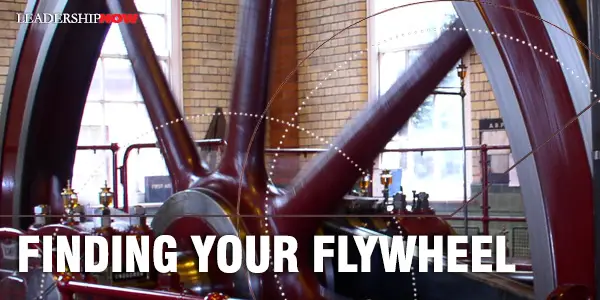
GREATNESS NEVER HAPPENS in one fell swoop—no single action. It is the result of a series of correct actions that build on each other. Jim Collins likens it to turning a giant, heavy flywheel. In Turning the Flywheel, he describes the process: Pushing with great effort, you get the flywheel to inch forward. You keep pushing, and with persistent effort, you get the flywheel to complete one entire turn. You don’t stop. You keep pushing. The flywheel moves a bit faster. Two turns … then four … then eight … the flywheel builds momentum … sixteen … thirty-two … moving faster … a thousand … ten thousand … a hundred thousand. Then at some point breakthrough! The flywheel flies forward with almost unstoppable momentum. The flywheel concept was first introduced in the bestselling Good to Great. In Turning the Flywheel, Collins shares practical insights and clarity about the process. You can see it at work in successful organizations, but the trick is finding your flywheel. While it your flywheel may be similar to another organization’s flywheel, “what matters most is how well you understand your flywheel and how well you execute on each component over a long series of iterations.” Collins lists seven essential steps to finding and capturing your flywheel. Collins explains the flywheels of Amazon, Vanguard, Intel, Giro Sport Design and others. Giro’s flywheel is illustrated below. As with all proper flywheels, each step or action in sequence is the almost inevitable consequence of executing the step before it. So, in the case of Giro, by creating a great bike helmet that elite athletes want to wear, it naturally inspires weekend warriors to wear it, which in turn attracts mainstream customers, which builds brand power and allows you the resources to invent more great products. And the flywheel turns faster and with more power.
If you understand your flywheel’s underlying architecture as distinct from a single line of business or arena of activity, you can evolve, expand, or extend your flywheel in response to changes in your environment. That is to say the underlying logic of your flywheel—what your organization is doing. If you understand that, you can apply it to other areas. Some Rules The very nature of a flywheel—that it depends upon getting the sequence right and that every component depends on all the other components—means that you simply cannot falter on any primary component and sustain momentum. Collins also makes it clear that a flywheel operates within a context—a framework of principles that great organizations adhere to. The framework has four stages: Stage 1: Disciplined People
The flywheel principle operates at the pivot point from Disciplined Thought into Disciplined Action. Collins explains each stage in detail and the principles that apply to each like Level 5 Leadership, the Hedgehog Concept, 20 Mile March, and Fire Bullets, Then Cannonballs. But I found this observation interesting: An overarching theme across our research findings is the role of discipline in separating the great from the mediocre. The only legitimate form of discipline is self-discipline, having the inner will to do whatever it takes to create a great outcome, no matter how difficult. When you have a disciplined people, you don’t need hierarchy. When you have disciplined thought, you don’t need bureaucracy. When you have disciplined action, you don’t need excessive controls. When you combine a culture of discipline with an ethic of entrepreneurship, you create a powerful mixture that correlates with great performance. Every entrepreneur should read this because it organizes your decisions around a principle that compounds your efforts. Turning the Flywheel is a short but necessary read to help you understand your business and what can and will make it successful. Executing well on a well thought out flywheel will give you years—even decades—of success. More importantly, if leaders communicate their organization’s unique flywheel so that everyone at every level understands it, it will bring clarity and purpose to each individual’s work. It provides tangible evidence as to their part in the organization’s success. 
Posted by Michael McKinney at 08:12 AM
02.11.19

Creating the Conversations That Help Them Grow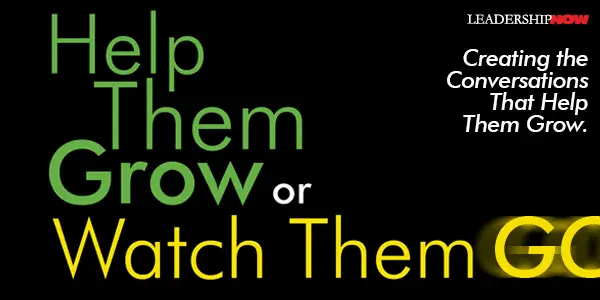
FINDING good employees is not enough. Developing them is critical to keeping them. Everyone has options. If you are not growing and leading your employees, they will look elsewhere. “Success today,” say Beverly Kaye and Julie Winkle Giulioni in Help Them Grow or Watch Them Go, “rests upon finding ways to continuously expand everyone’s capacity, engagement, and ability to contribute to the organization.” While many leaders may feel they don’t have time for career development, it’s not as complicated as we often make it out to be. “Career development is nothing more than helping others grow”—one conversation at a time. “Quality career development boils down to quality conversations”—frequent, short conversations that occur within the natural flow of work. It is based on good questions, not in having all of the answers. Go ahead and courageously ask the challenging questions and even end the conversation with a real tough or thought-provoking one that the employee can contemplate for a while. Closure is overrated. Unfinished business … that’s what will cause employees to continue to ponder and will ultimately spark action and feed progress. They suggest that we “reframe career development in such a way that responsibility rests squarely with the employee and that our role is more about prompting, guiding, reflecting, exploring ideas, activating enthusiasm, and driving action.” Their framework for career development is organized around three types of conversations: Hindsight Conversations “Hindsight conversations are the foundation of career development.” These conversations are meant to help develop self-awareness—where they have been, what they’ve done, and who they are. This has two parts: self-perception and other-perception—how others perceive them. Encourage employees to get feedback from those they work with. “Helping people look back and inward also provides a reservoir of information that allows employees to move forward and toward their career goals in intentional ways that will produce satisfying results.” Foresight Conversations What an employee learns about themselves in hindsight needs to be applied in the context of what is going on around them and the implications of all of the changes they see happening. “When you help your employees develop the ability to scan the environment, anticipate trends, and spot opportunities, you provide a constructive context for career development.” Harness the power of your crowd. Get them asking questions like, what are you seeing and what might these things mean to our industry, our organization, and your career? “Encouraging employees to interact directly with the environment is just an exercise until you debrief their experiences and encourage reflection.” It’ll turn employees into business partners. Insight Conversations These conversations leverage what your employee learns from the convergence of the insight and foresight conversations. Here you guide them into practical steps they can take to be where they want to be. “Onward and upward has been replaced by forward and toward.” Today, it’s not about moving up the ladder but moving to the place you want to be. Kaye and Giulioni suggest that we learn to help them grow in place. This requires a shift in thinking. “The challenge of growing in place involves stripping titles from our thinking and instead focusing on what the employee needs to experience, know, learn, and be able to do.” Reframe the conversation to be about experiences, not position. It creates unseen possibilities and allows them to grow where they are. Develop a Career Development Culture Ultimately what you want to create is a career development culture that supports and values the employee. Cultures that actively support career development and enjoy its constructive byproducts share some fundamental characteristics or cultural markers. They tend to be:
We have conversations about the work anyway, so why not make it a teachable moment. “A few minutes of conversation can help others slow down enough to reflect, bring deep insights to the surface, verbalize important messages, and consider how to leverage their expanding skills and knowledge base.” If you don’t think you have the time to incorporate this vital task in what you do, this book is for you. Kaye and Giulioni offer templates, guidelines, and sample conversations and questions that you can adapt to your own situation. With their approach, career development stays fresh because each employee’s career plan is unique and done in real-time.

Posted by Michael McKinney at 12:04 AM
02.08.19

Henry Mintzberg’s Bedtime Stories for Managers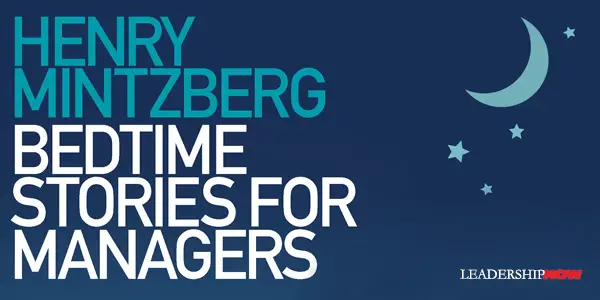
MINTZBERG’S 20th book, Bedtime Stories for Managers, is a thought-provoking page-turner. (In that sense I’m not sure it’s good to read just before drifting off.) The stories—a collection or repurposed blog posts—are meant to be pondered. The theme running through most is that managers/leaders need to get out from behind their desks and see the world from the perspective of their employees and customers. To this end, he dedicates the book to “all those managers who eat the scrambled eggs to help their organization work like a cow.” That requires some explanation. Scrambled Eggs The first story tells of an experience he had on the soon to be defunct Eastern Airlines (they went bankrupt in 1991). He was served some awful scrambled eggs. After complaining to the flight attendant, she said, “I know. We keep telling them; they won’t listen.” Management is not eating the eggs. They’re not running the business; they’re reading financial statements. The financial analysts were certainly reading those statements, and probably explaining the airline’s problems in terms of load factors and the like. Don’t believe a number of it. Eastern Airlines went belly up because of those scrambled eggs. And here’s the kicker: Some years later, after telling this story to a group of managers, one of them, from IBM, came up to tell me another story. The CEO of Eastern Airlines came rushing in at the last minute for a flight, he said. First class was full, so they bumped a paying customer to put him where I guess he had become accustomed. Apparently feeling guilty, he reportedly made his way to Economy Class (no mention was made of him having to ask where it was). There he apologized to the customer, introducing himself as the CEO of the airline. The customer replied: “Well, I’m the CEO of IBM.” The lesson is that managers/leaders (both sides of the same coin) need to get out and run their businesses. They need a dose of reality. “Managing is not about sitting where you have become accustomed,” writes Mintzberg. “It’s about eating the scrambled eggs.” Work Like a Cow In section 2 we learn about the cow. It comes as a reaction to a clever and insightful 1995 advertisement from SAP. In the ad, the copy reads: “This is an organizational chart that shows the different parts of a cow. In a real cow the parts are not aware that they are parts. They do not have trouble sharing information. They smoothly and naturally work together, as one unit. As a cow. And you have only one question to answer. Do you want your organization to work like a chart? Or a cow?”
This is a very serious question. Ponder it. Cows have no trouble working like cows. Nor, for that matter, does each of us, physiologically at least. So why do we have so much trouble working together socially? Are we that confused about organizing, for example, all this obsession with charts? Other Lessons A few of the stories take a concept or two out of context to make a point, but the point is well taken. Here are a few lessons gathered from the pages of Bedtime Stories for Managers: Successful managers are flawed—everyone is flawed—but their particular flaws are not fatal under the circumstances. Reasonable human beings find ways to live with one another’s reasonable flaws. The stories serve best as sort of a reality check. Good night. 
Posted by Michael McKinney at 12:51 AM
02.06.19

Scaling Leadership
THE INEVITABLE CONSEQUENCE of leading in an increasingly complex world is that we will have developmental gaps in our leadership. As our context change, we have to grow with it. In the words of Robert Anderson and William Adams, authors of Scaling Leadership, “We are running an Internal Operating System that is not complex enough for the complexity we face. This is our Development Gap.” We are often pushed to our limits. The solution is to scale our leadership. Leadership must learn to scale itself, but not any kind of leadership will do. We need much more of the kind of leadership that is capable of scaling innovation, adaptability, sustainability, agility, and engagement as its growth strategy. Scaling leadership is about becoming the kind of leader that scales the conscious leadership capable of creating what matters most of all the stakeholders it serves. So just what is this “conscious leadership?” To answer this question, they asked 50,000 leaders and employees worldwide, “What kind of leadership, if it existed, would enable the organization to thrive in its current marketplace and into the future?” The answer is displayed in the Optimal Leadership Circle Profile below. The top half of the circle are the 18 Creative Competencies that lead to leadership effectiveness. The bottom half is comprised of 11 Reactive Tendencies. These are our go-to strengths and behaviors we rely on when we feel under pressure. The reactive tendencies often get the job done but at a cost—disenchanted and disengaged employees and stakeholders that feel bullied or let down.
In order to scale your leadership, the right conditions must exist. First and foremost, we have to consciously move our leadership from reactive to creative. Also a Generative Tension or Strategic Intent must exist as leaders take responsibility for and establish a development agenda for themselves and their organization. Finally, as represented by the top half of the inner circle, four more conditions must exist: Relating or Deep Relationship, Self-Awareness, and Authenticity or Radically Human, Systems Awareness or Big Picture, and Achieving or Purposeful Achievement. How do you show up as a leader? Creative? Reactive? In their study, High-Creative leaders consistently demonstrated the following 10 strengths. Interestingly, the first four represent the areas with the highest leadership gaps—areas where leaders need the most work.
It’s not surprising that these were the most strongly endorsed strengths. People perform better when respected and your leadership is perceived as better when you are respectful. As Bill Adams father told him growing up, “How you get results is as important as the results themselves.” It’s easy to forget in a world where the end seems to justify the means. In the authors consulting work they have found that when leaders derail it’s because while they are very talented, they are highly reactive. They underuse their High-Creative strengths. Often what got them where they are, is no longer working in their new leadership context. Their research indicates areas that all leaders need to consider and develop where necessary. But of course, simply following a list is a bit simplistic. Or to say because I am relational, I’m a better leader. Because I’ve got good people skills, I’m naturally effective. We all come to leadership with strengths and weakness. Learning to honestly face where you need work and where you need to temper your strengths, is the sign of a great leader. Scaling leadership is a good place to begin the journey. In conclusion, the authors state that there’s more. Creative Leadership alone isn’t going to get the job done. “No matter how you cut it, we are up against a level of escalating complexity and disruptive change that requires, and will continue to require, an unprecedented level of innovation, adaptability, scalability, sustainability, resilience, collective intelligence, engagement, empowerment, agility, systemic thinking, and global cooperation.” What we need they term Integral Leadership “supported by a Self-Transforming Internal Operating System in some depth.” That’s to say we are no longer leading for ourselves but for a purpose larger than ourselves that comes through in everything we do. It means we go deeper to develop our character—who we are. We no longer sponsor change in the organization, we radically, humanly, and in deep relationship lead change from the perspective that the system is mirroring the function and dysfunction in us, individually and collectively. We project our shadow less and less, and therefore, we can engage conflict without reactively making the other into an enemy or adversary. We experience others as much like us, a work in progress, and we engage in dialogue from a place of listening, learning, compassion, and strength. Humility. Empathy. Faith. Grace. We are more alike than different. Integral leadership sees through our differences “to a deeper unity that we all share—that we all are. We are all each other.” You can learn more about the Leadership Circle Profile and take your free self-assessment on the Leadership Circle website. 
Posted by Michael McKinney at 12:16 AM
02.04.19

Simple Techniques to Overcome Negative Emotions When Negotiating with Others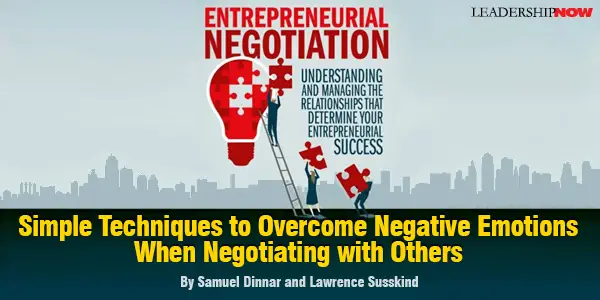
A KEY PREDICTOR of entrepreneurial success is a leader’s ability to manage relationships with investors, employees, and customers. Relationships are negotiations. We all negotiate. How well we learn to negotiate can be the difference between success and failure.
Here we will look at one aspect of successful negotiating: our emotions. The mishandling of emotions – especially tension and mistrust – is a major source of errors when negotiating. It can lead to miscommunication, misjudging the other party’s motives, inability to reach consensus, and more. In our book Entrepreneurial Negotiation, we explain that the best way to diffuse negative emotions is to prevent them from escalating in the first place. Diffuse Tension Before It Escalates At the beginning of every negotiation, there is a natural tension in the air. The higher the stakes, the higher the tension level. To diffuse it, open by conveying your sincerity and warmth with a handshake, eye contact, and a smile, as appropriate. Other ways of reducing tension in the first few minutes are sharing airtime while projecting genuine interest, showing respect and asking for agreement on some small initial ground-rule (e.g., use of first or last names, seating arrangements, etc.). A 2004 experiment using sociometric badges in a mock negotiation (between a corporate vice president and a middle manager) demonstrated that “tone of voice” used by participants in the first five minutes predicted more than a third of the variation in the objective and subjective outcome of a negotiation. They also found that turn-taking dynamics (who speaks when) had a strong correlation with the subjective value levels reported after the negotiation. Still, other studies showed that similarity, also called affiliation, is a primary factor that influences personal human connection – the building of rapport between individuals. Rapport reduces stress and is the best predictor of success in relationships. As a negotiation proceeds to more difficult topics, good negotiators maintain a relaxed tone (with the appropriate level of seriousness) while respecting their counterpart’s autonomy and status. The Power of Humor, Stories, and Metaphors Several additional tools that are often used to reduce stress are storytelling, metaphors, and humor. The appropriate use of humor, especially, can serve as a release valve for negative emotions such as anxiety, suspicion, and anger, and can create room for people to put things in perspective. Humor can also serve as a way of acknowledging the absurdity of the moment, where parties have inadvertently locked themselves into extreme positions. Humor does need to be used carefully. If a party doesn’t understand an attempt at humor, they may be left wondering if the joke is on them. If they feel as if they are the target (or that they are being taken lightly), it will most likely make the situation worse. Finding the right balance between humor and serious intent can make it easier to deal with escalating competitive behavior. Stories have the power to convey an important idea, stimulate a strong emotional response, and allow a release of political or interpersonal tension. They help to shift everyone’s focus from the tension in the room to the tension in the story. At the conclusion, when the story’s tension is finally released – both the listeners and the storyteller experience a stress-reducing feeling. Our brains react to stories the same way they react to true events. Using metaphors is also effective. For example, in negotiating the break-up of a business, framing the situation as a pile of cash to be divided creates a “divide the pie” metaphor. This is likely to induce a win-lose mindset. Using a story about a “cash cow” might shift the focus to a living creature that cannot be divided, but if taken care of will produce dividends over time. This second framing metaphor would more likely induce a collaborative discussion of how to share responsibilities and allocate future profits. Apologize Quickly and Sincerely f you realize you have done something that has hurt the other side, you should issue an apology immediately. It is rarely to your advantage to provoke feelings of fear, anger or resentment. A sincere apology can often restore a better working context. Apology is a social ritual that shows respect and empathy to the offended person. While you cannot undo a mistake, an apology can help the other side move on. This is the opposite of what happens when a person is emotionally triggered. Experiments show that receiving an apology reduces heart rate, breathing rate, sweat levels, facial tension, and blood pressure. Apologizing quickly and sincerely shows that you take responsibility for your actions. On your side, it can also prevent a buildup of remorse or shame caused by the fact that you hurt someone or simply as a result of having made an error. It is not easy, and quite humbling to apologize, but when done correctly it projects the inner strength of someone who is confident and aware of the feelings of others. Even when you apologize immediately, don’t rush things. It takes time for impacted emotions to wash over the other side. The body needs time to recover and to switch from fear, anger, and anxiety to empathy and compassion. Be present and attentive. Accept the silence as OK, and don’t move on prematurely. You may need to repeat your apology, since it may not have been fully heard or absorbed the first time. Focus on your counterpart’s reactions. Wait for them to indicate that it is OK to continue. Some mistakes are minor, and it will be easier for the other side to recover from these, even without an apology. Some will require both sides to cool off before continuing. After you have apologized and demonstrated your sincere intent to remedy the situation, you may want to revisit the item that was on the agenda when you made the mistake initially. Ask for a “do-over.” This is the ultimate “detect and respond” response: an “on-the-spot” apology that is accepted, coupled with permission to return to the negotiation. Negotiations are fraught with tensions. Learning to reduce tension and negative emotions creates a better outcome for everyone.  
Posted by Michael McKinney at 11:43 AM
02.03.19

Super Bowl Edition: Julius Peppers Retires from the NFL 
Dignity and class. On and off the field, Julius Peppers was a leader. New England Patriots quarterback Tom Brady said, “Julius has had an incredible impact in the NFL from the day that he came in. What an amazing player over the course of a long period of time. Just incredible physical, mental toughness. What an incredible career.” New England Patriots tight end Rob Gronkowski recalls, “I remember my first time lining up versus him, and I looked up and I was like 'This dude's a freak! His arms are like five times bigger than mine! He's a great player, and it was just an honor to be able to compete versus him.” Los Angeles Rams defensive tackle Aaron Donald remembers, “He's one of the best to ever do it. Made a lot of plays. I remember as a kid watching him play. Just a whole lot of respect for him. I remember being at a Pro Bowl, got an opportunity to talk to him and try to, like, feed off of him, ask him questions. One heck of a football player.” His accomplishments on the field are impressive but off the field, he demonstrated leadership, community, and empathy. In February 2009, Peppers donated $500,000 to a scholarship program that supports black students at his alma mater the University of North Carolina at Chapel Hill. After Hurricane Florence, the North Carolina native started the Julius Peppers Hurricane Florence relief fund by donating $100,000 and encouraged his teammates and other NFL players to join in. Actively involved in the recovery efforts, he told the Charlotte Observer, “I think a big part of the solution to these problems, and a big part of the help is the volunteers. People actually getting out there on the ground, putting in the work, going around helping other people and showing compassion for your neighbors. That really left an impression on me. ...People need to know that we’re all a big community and we all need help from time to time.” Julius Peppers announced his retirement Friday, February 1 after seventeen years in the NFL. He left us this video: “Thank you.
And thank you, Julius, for showing us the mind of a leader.
Posted by Michael McKinney at 09:02 AM
02.01.19

First Look: Leadership Books for February 2019Here's a look at some of the best leadership books to be released in February 2019. Don't miss out on other great new and future releases.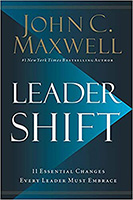 Leadershift: The 11 Essential Changes Every Leader Must Embrace Leadershift: The 11 Essential Changes Every Leader Must EmbraceJohn C. Maxwell In Leadershift, John C. Maxwell helps leaders gain the ability and willingness to make leadership changes that will positively enhance their organizational and personal growth. He does this by sharing the eleven shifts he made over the course of his long and successful leadership career. Each shift changed his trajectory and set him up for new and exciting achievements, ultimately strengthening and sustaining his leadership abilities. 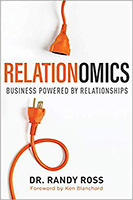 Relationomics: Business Powered by Relationships Relationomics: Business Powered by RelationshipsDr. Randy Ross with a Foreword by Ken Blanchard In Relationomics, Dr. Randy Ross lays out the principles and practices that will help readers develop and sustain the kind of relationships that can build their business and energize their team, including how to become a value creator, master the art of giving and receiving helpful feedback, dramatically decrease employee turnover, lead beyond self-interest, and much more. 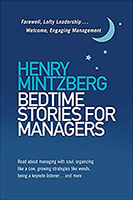 Bedtime Stories for Managers: Farewell, Lofty Leadership . . . Welcome, Engaging Management Bedtime Stories for Managers: Farewell, Lofty Leadership . . . Welcome, Engaging ManagementHenry Mintzberg If you're like most managers and things keep you up at night, now you can turn to a book that's designed especially for you! But you won't find talking rabbits or princesses here. (There is a cow, but it doesn't jump.) Henry Mintzberg has culled forty-two of the best posts from his widely read blog and turned them into a deceptively light, sneakily serious compendium of sometimes heretical reflections on management.  Brave New Work: Are You Ready to Reinvent Your Organization? Brave New Work: Are You Ready to Reinvent Your Organization?Aaron Dignan Dignan says you can’t fix a team, department, or organization by tinkering around the edges. Over the years, he has helped his clients completely reinvent their operating systems—the fundamental principles and practices that shape their culture—with extraordinary success. Seth Godin says, “This is the management book of the year. Clear, powerful and urgent, it's a must read for anyone who cares about where they work and how they work.”  The Enlightened Capitalists: Cautionary Tales of Business Pioneers Who Tried to Do Well by Doing Good The Enlightened Capitalists: Cautionary Tales of Business Pioneers Who Tried to Do Well by Doing GoodJames O'Toole James O’Toole tells the largely forgotten stories of men and women who adopted forward-thinking business practices designed to serve the needs of their employees, customers, communities, and the natural environment. They wanted to prove that executives didn’t have to make trade-offs between profit and virtue.  Build your leadership library with these specials on over 39 titles. All titles are at least 40% off the list price and are available only in limited quantities. “Books, because of the power they possess to exert intellectual influence, more so than any other form of serious communication, change the way readers — and even leaders — see the world and set the stage for them to change it.” — Peter J. Dougherty, editor-at-large at Princeton University Press
 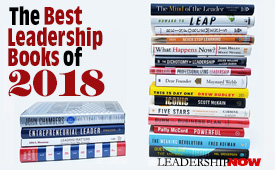
Posted by Michael McKinney at 01:18 AM
|
BUILD YOUR KNOWLEDGE


How to Do Your Start-Up Right STRAIGHT TALK FOR START-UPS 
Grow Your Leadership Skills NEW AND UPCOMING LEADERSHIP BOOKS 
Leadership Minute BITE-SIZE CONCEPTS YOU CAN CHEW ON 
Classic Leadership Books BOOKS TO READ BEFORE YOU LEAD |
|